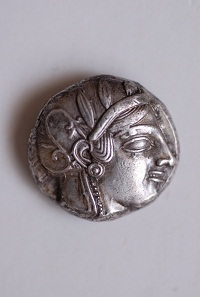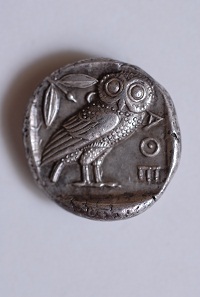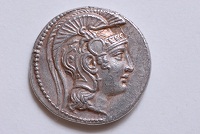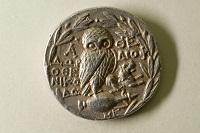Portraits of Greek Coinage - 'Athens'

 |
ARTetradrachm. c.450 BC.
17.18g (21/23mm diameter). Die axis, 315˚.
Author's collection. Ex Spink, NCirc, August 2000, 2843. Cf. Starr, 196.
Obv. Head of Athena r., wearing helmet decorated with three olive leaves and a curling palmette. Hair in two even loops across brow and temple. Disc shaped earring. Beaded edge to nape of helmet.
 |
Rev. Owl standing r., body leaning to r. with facing head slightly tilted. Conjoined tuft of tail feathers. Olive sprig and crescent to left and AΘE to right.
The Athenian tetradrachm is possibly the best known and most illustrated of all ancient Greek coins. Its reverse - to choose but one example - graces the cover and spine of Hammond's history of ancient Greece. [1]This is not surprising. The defeat of the Persian orces of Darius, at Marathon in 490 BC, heralded a golden age for Athens which lasted until the disastrous Peloponesian War led to its subjection to Sparta in 404 BC. In the intervening period Athens consolidated a successful democracy, expanded its political and economic power across the Greek world and created an environment in which artistic and intellectual activity could thrive as never before or since. Military and naval might was underpinned by the copious silver mined at Laurium, as well as payments from tributary powers and from the treasury of the Delian League.
Thus, Athenian coinage symbolised political dominance and was, itself, a tangible expression of economic power. There is, however, a third ingredient which has helped the coinage to achieve a unique status. That is the vigorous image conveyed at this period by the design and execution of the coins themselves. The impact was sustained by continuing the design over decades with only the subtlest of change, maintaining - in
modern parlance - a consistent message, as befitted an issue of international importance. The greatly inferior evolution of the Athena/owl designs in the following centuries would have been unthinkable in the fifth century BC. Figures C and D show one of the 'New Style' tetradrachms struck in 164/3 BC.
|
Obverse (Figure C) |
|
Reverse (Figure D) |
Obv. Head of Athena, wearing a drop earring and triple crested helmet embellished with an image of Pegasus and foliage, and the forepart of four horses r. on the visor. Curls by cheek and nape of neck. Border of pellets.
Rev. Owl turned partly r., with facing head, perched on an amphora (the usual letter erased by wear). A/ΘΕ on either side of bird. Extensive lettering in the field and, to the right of the bird, the forepart of a lion r.
16.98 (30mm diameter). Die axis, 315˚.
Author's collection. Ex Spink, 2008.
Here the portrayal of Athena is executed with careful attention to detail but drained of character. In contrast, the owl on the reverse is surprisingly crude compared with Figure B and whatever impact the design might have had is choked by the clutter of lettering in the field.
Unerringly the obverses of Athenian tetradrachms bear the head of the goddess, the only Greek deity to give its name to a city or state [2]. She was the patroness of crafts and warlike protectress of cities. [3] The helmet and olive leaves in Figure A stress her latter role. Her portrayal in that Figure is in assured archaic style, and manifests a disturbingly arresting and mysterious face. This is partly brought about by the eye being engraved to face the onlooker instead of being in profile and with this die Athena's teeth being visible, accentuating her uncompromising appearance.
The contrast with the reverse is remarkable. The owl is a friendly creature. He (if indeed he is such) could easily be imagined aboard a pea-green boat. His posture on the coin illustrated is of an alert little bird looking out upon the world with expectant curiosity.
Although the Greeks did not consider birds to be divine, many were associated with the gods. Athena takes the form of various species in Homer but her link with the owl appears to be later. [4] Its effigy was on the state seal of Athens and on the coins complements the inscription AΘE. The species portrayed is that known to ornithologists as the Little Owl (Athene noctua). Florence Nightingale found one on a visit to the Acropolis and kept it as a pet. [5] It may have been a remote descendent of those nesting there in ancient times. [6] The olive is also associated with Athena and with Attica as an important producer of oil. [7] Interpretation of the crescent is more precarious. It may simply represent the waning moon, companion to the nocturnal bird. Its introduction has been linked to the Panathenaic Festival in July - August 514 BC, [8] but this does not accord with more recent research, dating the addition to c. 478 - 470 BC. [9] It has also been linked to the state of the moon at the time of the battle of Salamis in 480 BC, but as Starr has observed, this is 'extremely hypothetical. [10]Once introduced, the crescent nevertheless remains a feature of the design well into the third century BC.
Another characteristic underlining the importance, in particular, of the Athenian tetradrachm was its sturdy shape. The dies used to strike the plump flans created a convex obverse prone to wear in use, but a reverse with the owl in high relief, protected within a deep concave frame. Curiously, as usually occurs on these coins, the bust of Athena on the coin illustrated is so large that the crest of her helmet is lost off the edge of the flan.
The weight of the coin illustrated, at 17.18g, corresponds with the Euboeic/Attic standard of 17.20g for a tetradrachm and 4.30g for a drachm. [11]
[1] N. G. L. Hammond, A History of Greece to 322 BC, 3rd edition (Oxford, 1986).
[2] The Oxford Classical Dictionary, edited by Simon Hornblower and Anthony Spawforth, 3rd edition revised (Oxford, 2003), p.202.
[3] Iliad, 5. 841-45.
[4] John Pollard, Birds in Greek Life and Myth(Plymouth, 1977), p.144; Oxford Classical Dictionary, p.244.
[5] At Claydon House in Buckinghamshire, there is a silver owl given to her by the 7th Duke of Devonshire in memory of her pet.
[6] Pollard, Birds in Greek Life, pp. 39, 143.
[7] Oxford Classical Dictionary, p.1064.
[8] Barclay V. Head, Historia Numorum (Oxford, 1911), p.370.
[9] Chester G. Starr,Athenian Coinage, 480 - 449 BC(Oxford, 1970), p.19.
[10] Ibid., p.11.
[11] C. M. Kraay and Max Hirmer, Greek Coins (New York), p.17.





